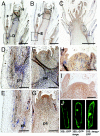A unique virulence factor for proliferation and dwarfism in plants identified from a phytopathogenic bacterium
- PMID: 19329488
- PMCID: PMC2669400
- DOI: 10.1073/pnas.0813038106
A unique virulence factor for proliferation and dwarfism in plants identified from a phytopathogenic bacterium
Abstract
One of the most important themes in agricultural science is the identification of virulence factors involved in plant disease. Here, we show that a single virulence factor, tengu-su inducer (TENGU), induces witches' broom and dwarfism and is a small secreted protein of the plant-pathogenic bacterium, phytoplasma. When tengu was expressed in Nicotiana benthamiana plants, these plants showed symptoms of witches' broom and dwarfism, which are typical of phytoplasma infection. Transgenic Arabidopsis thaliana lines expressing tengu exhibited similar symptoms, confirming the effects of tengu expression on plants. Although the localization of phytoplasma was restricted to the phloem, TENGU protein was detected in apical buds by immunohistochemical analysis, suggesting that TENGU was transported from the phloem to other cells. Microarray analyses showed that auxin-responsive genes were significantly down-regulated in the tengu-transgenic plants compared with GUS-transgenic control plants. These results suggest that TENGU inhibits auxin-related pathways, thereby affecting plant development.
Conflict of interest statement
The authors declare no conflict of interest.
Figures




References
-
- Bertaccini A. Phytoplasmas: Diversity, taxonomy, and epidemiology. Front Biosci. 2007;12:673–689. - PubMed
-
- Christensen NM, Axelsen KB, Nicolaisen M, Schulz A. Phytoplasmas and their interactions with hosts. Trends Plants Sci. 2005;10:526–535. - PubMed
-
- Oshima K, et al. Reductive evolution suggested from the complete genome sequence of a plant-pathogenic phytoplasma. Nat Genet. 2004;36:27–29. - PubMed
Publication types
MeSH terms
Substances
Associated data
- Actions
- Actions
LinkOut - more resources
Full Text Sources
Other Literature Sources
Molecular Biology Databases

